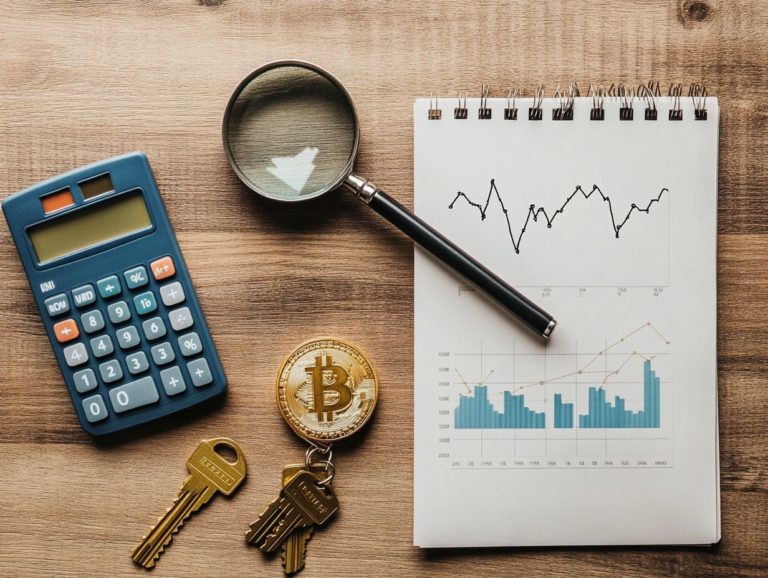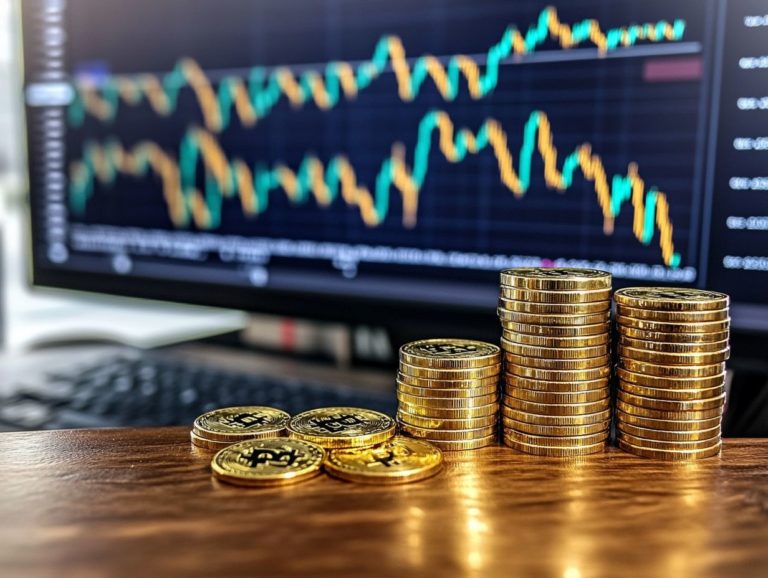Understanding the Market for Physical Assets
Physical assets are essential to your investment strategies. They provide tangible value that stands resilient against market fluctuations.
This article delves into the definition and various types of physical assets, ranging from real estate to collectibles. It also examines the factors that influence their market dynamics, including economic conditions and availability.
You ll uncover the benefits and risks tied to investing in these assets. Gain insights into evaluation metrics and explore alternative investment options.
Get ready to explore the exciting world of physical asset investment with confidence and clarity.
Contents
- Key Takeaways:
- What are Physical Assets?
- What Affects the Value of Your Physical Assets?
- Benefits of Investing in Physical Assets
- Risks of Investing in Physical Assets
- How to Evaluate Physical Assets for Investment
- Alternative Options for Investing in Physical Assets
- Frequently Asked Questions
- What is meant by the term “physical assets” in the market?
- Why is it important to understand the market for physical assets?
- What factors influence the market for physical assets?
- How can I determine the value of a physical asset?
- What are some common types of physical assets in the market?
- How can I invest in the market for physical assets?
Key Takeaways:

- Diversify your portfolio with physical assets like real estate, precious metals, and collectibles.
- Stay informed on economic conditions and demand trends to make smart investment choices.
- Understand that while physical assets can offer stability, they come with risks like market fluctuations and storage costs.
What are Physical Assets?
Physical assets are tangible items that possess intrinsic value. They can generate revenue or support operational functions within your organization. They include a diverse array of goods such as machinery, vehicles, and real estate, which are crucial to effective investment management.
Understanding these physical assets is vital for you to optimize their lifecycle. This includes enhancing operational performance and ensuring compliance with various regulations.
Definition and Types of Physical Assets
Tangible assets are the physical items you own. They can be classified into various categories, including equipment, machinery, and infrastructure. These assets are essential for your organization s daily operations and overall productivity.
Take machinery, for example. It keeps the manufacturing processes running smoothly and influences the quality and speed of production. Likewise, equipment whether office tools or heavy-duty machines is crucial for maintaining workflow efficiency.
Understanding the condition of your tangible assets is also vital. Asset condition monitoring enables you to evaluate performance and anticipate maintenance needs. This strategic oversight ensures that how well you can run your business is maximized while minimizing unexpected downtimes.
What Affects the Value of Your Physical Assets?
The market for physical assets is shaped by many factors, including economic conditions and fluctuations in demand. These elements directly impact supply and overall performance, creating a dynamic environment that requires your careful attention.
Economic Conditions and Demand
Economic conditions significantly influence your demand for physical assets. They shape how you approach investment opportunities.
For instance, during periods of inflation, the value of money diminishes. This pushes you to seek tangible assets such as real estate or machinery that tend to retain their value more effectively. Understanding the liquidity of physical assets is crucial in these scenarios. Conversely, in times of recession, your organization may face reduced cash flow, prompting necessary adjustments to your asset portfolio.
By grasping these dynamics, you can strategically diversify your investments across various asset classes. If some underperform, others can still deliver steady returns. Optimizing asset utilization during both inflationary and recessionary periods can safeguard against financial instability and position your organization for future growth.
Supply and Availability

Supply and availability of physical assets are critical. They shape your efficiency and performance in many industries.
In today s fast-paced market, the dynamics of the supply chain can dramatically affect how readily these assets are available for your daily operations. Disruptions, whether stemming from natural disasters, transportation delays, or supplier complications, can create shortages that significantly impede productivity.
This is where systems that track assets become essential. They provide real-time insights into your inventory levels and asset locations, allowing you to navigate challenges with agility.
Equally important is the maintenance of your infrastructure. Regular upkeep of facilities, machinery, and equipment ensures that your physical assets remain in peak condition, fully prepared to meet operational demands without unnecessary delays or interruptions.
Benefits of Investing in Physical Assets
Investing in physical assets offers incredible advantages that can transform your organization! These include stability and diversification. Such elements enhance your organization s overall ROI and foster sustainable practices across various sectors.
Stability and Diversification
Stability and diversification stand as pivotal advantages when investing in physical assets. They offer a protective buffer against market volatility and enhance your financial security.
By integrating tangible investment avenues like real estate, commodities, or precious metals, you can cultivate a well-rounded portfolio that acts as a safeguard during economic downturns. This strategic approach mitigates risks from fluctuating markets. It also provides a more predictable return on your investment.
Conducting regular asset audits is essential for maintaining overall stability. These assessments track performance and highlight underperforming assets. This proactive measure enables you to make informed adjustments, ensuring that your investment strategies remain in harmony with evolving market conditions and your personal financial goals.
Inflation Protection
Investing in tangible assets serves as an effective hedge against inflation, ensuring that the value of your investments remains strong over time.
Assets like real estate and precious metals have a proven track record of appreciating in value, even as the purchasing power of your currency dwindles. By strategically incorporating these assets into a diversified portfolio, you can protect yourself from economic fluctuations while maximizing your ROI. Additionally, understanding market trends for paper assets can further enhance your investment strategy.
The use of predictive analytics which uses data to forecast trends and outcomes is essential in this strategy. It allows you to monitor performance metrics in real-time, anticipate market shifts, and adapt your approach during inflationary periods. This enables you to make informed decisions and bolsters the overall resilience and profitability of your investment portfolio.
Risks of Investing in Physical Assets
Investing in physical assets can certainly be advantageous, but it also comes with risks. You must consider market volatility, liquidity challenges, and the various costs associated with storage and maintenance.
Market Volatility and Liquidity

Market volatility and liquidity pose significant risks that can impact the performance of your physical asset investments. This makes careful risk management strategies essential.
When you encounter sudden swings in market dynamics, you could face urgent liquidity issues that complicate your decisions. This constraint can push you to prioritize short-term gains over long-term stability.
To navigate these challenges effectively, it s crucial to engage in regular audits and implement proactive management practices. By doing so, you can identify potential vulnerabilities within your portfolio and make informed choices that safeguard against unexpected downturns. This ensures a more resilient investment strategy in an unpredictable market landscape.
Storage and Maintenance Costs
Storage and maintenance costs are critical factors that impact the performance and profitability of your investments.
When these expenses accumulate, they can erode your returns. Effective management is essential to maximizing your ROI.
Consider using regular maintenance plans, like scheduled servicing and inspections, to prevent costly breakdowns.
Asset tracking tools can help you monitor your equipment s condition and usage patterns, leading to better decisions.
Maintain a clean and organized storage environment to reduce unnecessary costs and keep your assets operational.
How to Evaluate Physical Assets for Investment
Evaluating physical assets for investment demands careful attention to several key metrics and factors that influence your asset management decisions.
Each element plays a crucial role in shaping a comprehensive understanding of the investment landscape.
Key Considerations and Metrics
Key considerations and metrics for evaluating physical assets encompass asset performance, condition, and potential investment opportunities.
Understanding these factors is essential for stakeholders who wish to make informed decisions regarding their portfolios.
Metrics such as return on investment (ROI), depreciation rates, and maintenance costs offer vital insights into an asset’s overall viability.
By leveraging effective asset tracking systems, you can monitor real-time data, which is crucial for assessing whether an investment aligns with your financial goals.
The ability to track an asset’s history and condition fosters transparency and enriches your strategic evaluation process.
This enables you to conduct a more thorough analysis of long-term value versus ongoing upkeep, ensuring that every decision you make is grounded in comprehensive data.
Alternative Options for Investing in Physical Assets
Exploring alternative avenues for investing in physical assets like real estate, precious metals, and collectibles offers a compelling opportunity for diversification and financial enhancement.
These tangible investments can stabilize your portfolio and provide unique advantages that contribute to your overall wealth strategy.
Real Estate, Precious Metals, and Collectibles

Real estate, precious metals, and collectibles are some of the most sought-after alternative options for investing in physical assets.
Each presents its own set of advantages and risks.
These investment options can boost your wealth significantly!
Real estate is appealing due to its ability to generate rental income and appreciate over time, even amidst market fluctuations.
Precious metals like gold and silver often serve as safe havens during economic downturns, but be prepared for potential price volatility.
Collectibles, from art to vintage wines, offer aesthetic value and unique liquidity challenges, yet they can appreciate significantly.
By understanding the specific risk profiles and market dynamics associated with each option, you position yourself to align them better with your overall asset management strategies.
This approach enhances your capacity for well-considered choices and allows you to manage risks diligently.
Frequently Asked Questions
What is meant by the term “physical assets” in the market?
Physical assets refer to tangible goods or properties that have value and can be bought or sold in the market, such as real estate, vehicles, equipment, and commodities.
Why is it important to understand the market for physical assets?
Understanding the market for physical assets is crucial for making informed investment decisions and assessing the value of assets you currently own.
It can also help predict trends and potential risks in the market.
What factors influence the market for physical assets?
Many factors affect the market for physical assets. These include supply and demand, economic conditions, interest rates, government policies, and consumer behavior.
How can I determine the value of a physical asset?
You can determine the value of a physical asset through market research or an evaluation by a professional. Comparing prices of similar assets and considering factors like location and condition is also helpful.
What are some common types of physical assets in the market?
Common physical assets include real estate properties, vehicles, precious metals, agricultural products, and machinery. Each type has its own unique value and market dynamics.
How can I invest in the market for physical assets?
You can invest in physical assets by purchasing them directly or by investing in companies that produce or sell them. Other options include real estate investment trusts (REITs) and exchange-traded funds (ETFs).















